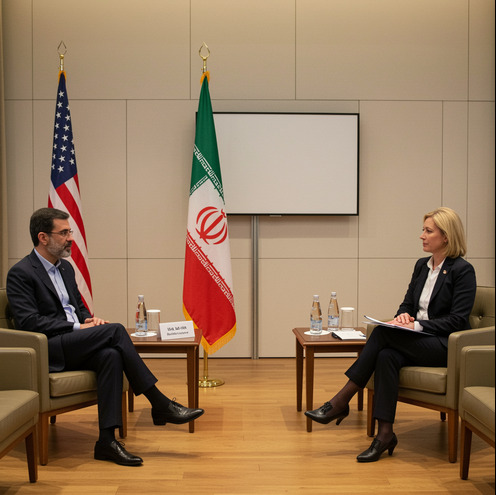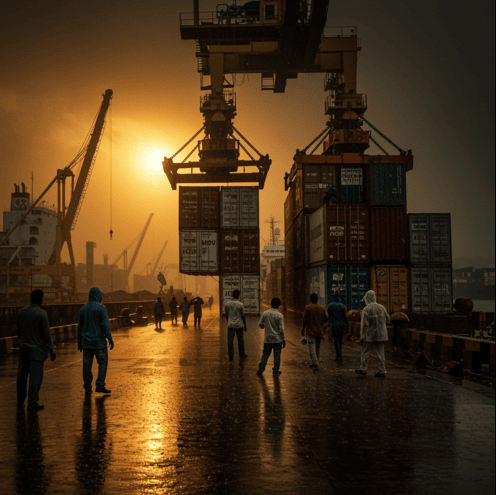One of the most challenging political connections of this century between Iran and the United States has recently initiated indirect nuclear talks that have attracted global notice.

The talks occur in Oman because this nation maintains a well-known diplomatic reputation through its discreet meetings and diplomatic mediation services. European representatives function as official government representatives to transmit communications between the United States and Iran, despite their officials remaining separate from discussions.
This development occurs when international stakeholders increasingly worry about Iran’s nuclear program and Middle East regional conflicts, and global interests for lasting peace.
Why Are the Talks Happening Now?
The United States maintains a strained relationship with Iran through its diplomatic channels since the previous years. The Joint Comprehensive Plan of Action (JCPOA) of 2015 created a peaceful agreement that let Iran reduce its nuclear activities in exchange for lifting sanctions through its Iran nuclear deal label. Donald Trump terminated his backing for the Iran nuclear deal through executive action in 2018 because he judged it ineffective. He then reinstated harsh sanctions against Iran.
Iran chose to abandon the JCPOA terms by progressing uranium enrichment levels above the constraints mentioned in the agreement. The possible progress toward a nuclear weapon capability by Iran caused international concern because Tehran officially declared it did not seek such weapons.
Numerous years of intensifying diplomatic strains have led both parties toward conversation, but they still need to avoid direct contact for now.
The United States officials want to stop Iran from creating nuclear weapons, yet Iran requests economic sanctions relief to help alleviate its deteriorating economic situation.
According to a senior diplomat mentioned in the talks, there is no basis for trust between these parties. The parties want to discover how they can move forward. Failure carries unacceptable expenses with it for both parties, according to their knowledge.
What Are Indirect Talks?
Negotiations between Iranian and American representatives take place indirectly because the groups maintain direct communication. The European diplomat team from the European Union moves between rooms while transporting communication messages and replies between Iran and the United States.
The method has previously been employed particularly during conflicts between hostile countries that lack established diplomatic relations. Iran and the United States created a diplomatic bond rupture following the 1979 Iranian Revolution but short periods of interaction failed to prevent their relationship from staying predominantly hostile.
From behind closed doors, parties can express themselves openly since indirect dialogues eliminate the political risks that emerge when talks are direct.
What Is Being Discussed?
The core issue in these negotiations deals with Iran\’s nuclear program\’s advancement towards developing a nuclear weapon, along with stopping this progress.
The main matters for consideration during these discussions involve:
1. Limiting Uranium Enrichment:
At present, Iran operates its uranium enrichment facilities to produce material with levels of 60% enrichment that are close to meeting weapon-grade requirements. According to its initial 2015 agreement, Iran had to uphold uranium enrichment at 3.67% while it now operates at 60%.2 %. Reducing Stockpiles:
The country continues to build up stores of enriched uranium at significant levels. Fairfield expected the discussions to confront Iran\’s enriched uranium storage levels through reduced stockpiles and performance caps.
2. Nuclear Site Inspections:
Foreign powers from the West want International Atomic Energy Agency (IAEA) inspectors to perform unrestricted assessments at each nuclear facility in Iran.
3. Sanctions Relief:
Iran wants the United States to lift all sanctions specifically addressed to oil exports and banking and economic restrictions. Sanctions relief remains a vital precondition for Iran since the country states it does not need to come back to any agreement without such relief. Hostage and Prisoner Issues:
There are reports that the two sides may also be discussing the release of prisoners — both Americans detained in Iran and Iranians held abroad.
Regional Tensions:
Though not officially part of the talks, tensions in the Middle East — especially conflicts in Syria, Iraq, and Yemen — are influencing the negotiations. The U.S. wants Iran to reduce support for regional militias, while Iran says it is defending its interests.
The Role of Other Countries
Several other countries and groups are playing important roles in these talks:
- European Union (EU): The EU is leading the mediation, especially through its diplomatic arm. The EU helped negotiate the original JCPOA and is trying to revive it.
- Russia and China: Both countries are technically part of the original deal and support a return to it. They also have close ties with Iran, though they are not playing a central role in the current round of indirect talks.
- Israel and Gulf States: Countries like Israel, Saudi Arabia, and the United Arab Emirates (UAE) are watching closely. Israel has repeatedly said it will never allow Iran to have a nuclear weapon, and has even threatened military action. Gulf countries worry about Iran’s influence in the region, but also want stability and the return of oil trade.
What Does This Mean for the World?
The successful talks would create multiple positive outcomes that include both Middle East regional quieting and enhanced diplomatic ties between Iran and Western nations, in addition to balanced global oil supply systems. The world faces too much risk of military conflicts, so the negotiations hold potential to minimize potential chances of armed confrontations.
The Persian Gulf routes managed by Iran trigger price hikes in oil markets because they permit huge amounts of petroleum products to pass through the Strait of Hormuz. The peaceful resolution of the situation would result in improved energy supply stability and possibly contribute to reduced fuel prices.
The negotiation breakdown may result in severe problems. The Iranian nuclear advancement may prompt other nations to reach for military strikes, which could autonomously trigger international warfare.
What’s Different This Time?
The current round of negotiations features a distinct difference where participants are managing minimal expectations between them. Officials this time pursue compact but functional advances instead of pursuing major developments like they did in 2015.
The negotiations might result in establishing a temporary arrangement instead of reapplying the complete terms of the JCPOA. The proposed agreement would include Iranian nuclear activity restrictions in exchange for restricted sanctions relief measures. The agreement would maintain a time frame for more dialogue, as it prevents instant escalation between the parties.
The political environment now presents a different picture from before. Iran\’s hardline political party maintains control over the government, yet faces opposition because of economic challenges and growing public opposition. President Joe Biden of the United States shows diplomatic intentions toward Iran, while Republicans and Democrats oppose his Iran policies.
The circumstances throughout the Middle East region have undergone recent changes. Israel, together with Iran-backed groups like Hezbollah, currently shows restraint to prevent a broader Middle Eastern conflict.
Public Reactions and Concerns
Public opinion on both sides is mixed.
In Iran, many people are suffering from high inflation, unemployment, and a lack of access to medicine and essential goods due to the sanctions. Many Iranians hope the talks can bring some relief.
One Iranian shopkeeper in Tehran said, “We just want to live a normal life. If these talks help us breathe, then let them talk.”
In the U.S., some worry that easing sanctions might let Iran continue its regional activities or delay the nuclear issue without solving it.
Some critics say, “Iran has used talks in the past to buy time. We need a tougher stance, not more talking.”
Supporters of the negotiations argue that diplomacy is the only realistic path. “War is not the answer. Talking doesn’t mean giving up. It means being smart,” said one U.S. official.
The Challenges Ahead
Despite the hopeful tone, many obstacles remain:
- Mistrust is high. Both sides accuse each other of past failures and broken promises.
- Domestic politics. Leaders in both Iran and the U.S. have to deal with critics at home who oppose compromise.
- Time is running out. The Iranian nuclear program continues its progress while time passes, which will lead to greater difficulty in striking a deal.
- * External pressures. Regional warfare, together with political turbulence, poses a risk for the ongoing discussions to fail.
- Multiple experts indicate that a partial agreement between the parties will start the process toward progress.
- What Happens Next?
- The talks will extend throughout the following weeks. The parties involved maintain open dialogue for more discussions, yet they have not established any deadline to achieve an agreement.
- The diplomatic representatives work towards creating mutual trust through accumulated smaller accomplishments. Those involved in the negotiation state that handling small developments today will generate larger advancements in the future.
- A Western diplomat stated that this process will extend for an indefinite duration. Whole journeys must start with setting foot first. The start of a new dialogue represents the first step towards progress that we expect to develop.
Conclusion
- Through their secretive exchanges, Iran and America seek to resolve their massive nuclear conflict using diplomatic approaches despite lacking daily media attention.
- Both parties maintain communication, although the path remains uncertain since several risks exist; however, this new engagement creates hesitant optimism.
- The world attentively observes the situation because the implications of this dialogue are high regardless of its future outcome.


